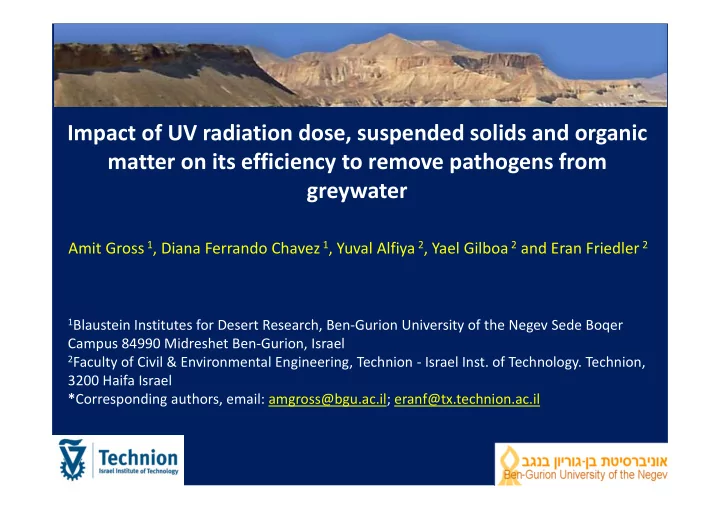

Impact of UV radiation dose, suspended solids and organic matter on its efficiency to remove pathogens from greywater 1 1 2 2 2 Amit Gross , Diana Ferrando Chavez , Yuval Alfiya , Yael Gilboa and Eran Friedler 1 Blaustein Institutes for Desert Research, Ben ‐ Gurion University of the Negev Sede Boqer Campus 84990 Midreshet Ben ‐ Gurion, Israel 2 Faculty of Civil & Environmental Engineering, Technion ‐ Israel Inst. of Technology. Technion, 3200 Haifa Israel * Corresponding authors, email: amgross@bgu.ac.il; eranf@tx.technion.ac.il
• Greywater (GW) is domestic wastewater excluding the toilet stream • Using GW may reduce domestic water use by up to 50% and typically used for gardening and toilet flushing • Many GW reuse standards require to lower indicator bacteria concentrations Disinfection is needed
E1 UV radiation damages bacterial/viruses nucleic acids (DNA/RNA) , thereby preventing them from replicating
Slide 3 E1 רתוימ הזה ףקשהש בשוח Eran; 6/9/2016
Advantages: Does not require addition of chemicals Effective on a wide range of pathogens Fairly simple and low cost operation and maintenance Safe for operators in general and in comparison to chlorination No by ‐ products Disadvantages: Disinfection is limited as a result of repair mechanisms No residual effect Fouling of the quartz sleeve decreases the efficacy of disinfection Insufficient water quality might reduce UV efficiency. Specifically, total suspended solids (TSS) and organic substances
Impact of particle “shielding” by absorption, scattering, refraction and reflection Impact of particles enmeshed/associated with microorganisms
• Investigate the efficiency of low ‐ pressure UV disinfection of GW under a range of: UV doses , TSS and dissolved BOD 5 concentrations • Develop a statistical model for the prediction of the impact of TSS and BOD 5 on disinfection efficiency • Correlate between a collimated beam results that is mostly used in the laboratory to flow ‐ through reactors which are mostly used in the field
Treated GW Variable Range Changing concentration 10 4 - FC of TSS and BOD 10 5 432 (CFU/100ml) combinations TSS (mg/L) 1-130 Each sample, 3 3-100 BOD (mg/L) replicates Recirculating vertical flow Collimated beam constructed wetland UV irradiation doses: 7.5, 15 and 30 mJ/cm 2
Household GW source Storage of Raw GW (bathroom and laundry) GW Biological Treatment Quality of pre ‐ disinfected Range treated GW from 11 onsite treatment systems UV Disinfected GW TSS (mg/L) 3.9-233 dose: 44 mJ/cm 2 0-107 BOD (mg/L) 39-85 % Transmission 254 nm 1.47-512 Turbidity (NTU) 0 - 10 6 FC (CFU/100ml) 8
D1 (7.5 mJ/cm2) D2 (15 mJ/cm2) D3 (30 mJ/cm2) 99.0 70 99.2 99.4 99.6 60 99.8 100 50 TSS (mg/L) 40 30 20 10 10 20 30 40 50 60 70 10 20 30 40 50 60 70 10 20 30 40 50 60 70 BOD5 (mg/L) BOD5 (mg/L) BOD5 (mg/L) As expected, disinfection efficiency increased with increasing UV dose and was negatively affected by the presence of TSS and BOD.
log FC removal= 1 ·[BOD]+ 2 ·[TSS]+ 3 ·[ log FC Gw ]+ 4 ·[ UV dose] Coefficient Estimate p ‐ value β 1 0.001 0.2211* β 2 ‐ 0.012 <0.0001 β 3 0.495 <0.0001 β 4 0.059 <0.0001
Flow through reactor Predicted log removal (log(CFU/100ml)) R 2 =0.84 p<0.0001 Removal (log(CFU/100ml)
For the same log removal dividing the measured UV dose in the flow ‐ through reactor by the model ‐ predicted UV dose (based on collimated beam results), resulted in a correction factor (CF) of 7.47 Reactor UV dose = 7.47 ∙ UV collimated beam
UV disinfection efficiency decreases as a result of increasing TSS concentration beyond a threshold value of 50 mg/L. As UV dose the influence of TSS (30 mJ/cm CB). The effect of dissolved organic substances on UV disinfection efficiency is significantly smaller than of TSS. It is possible to predict GW disinfection efficiency by simple MLR model take it into consideration for system design. A correction factor (7.5) was established between Laboratory based collimated beam results and Field, flow through reactors
E2 E3 The research was supported by Rosenzweig ‐ Coopersmith Foundation and the Zuck Maccabi Fund . 15
Slide 15 E2 תינוויב תולאשל תילגנאב יוטיבה Eran; 6/9/2016 E3 erotíseis Eran; 6/9/2016
Recommend
More recommend